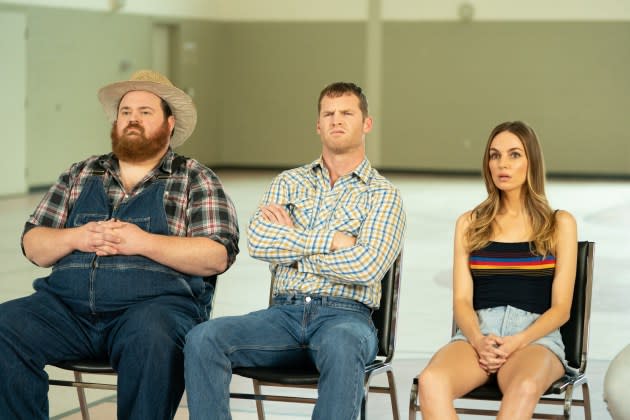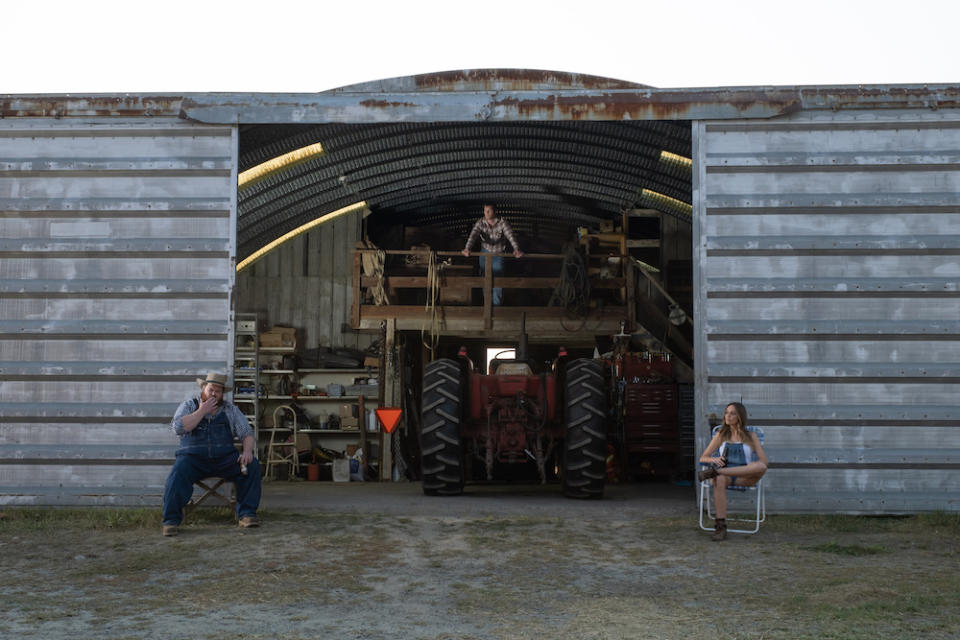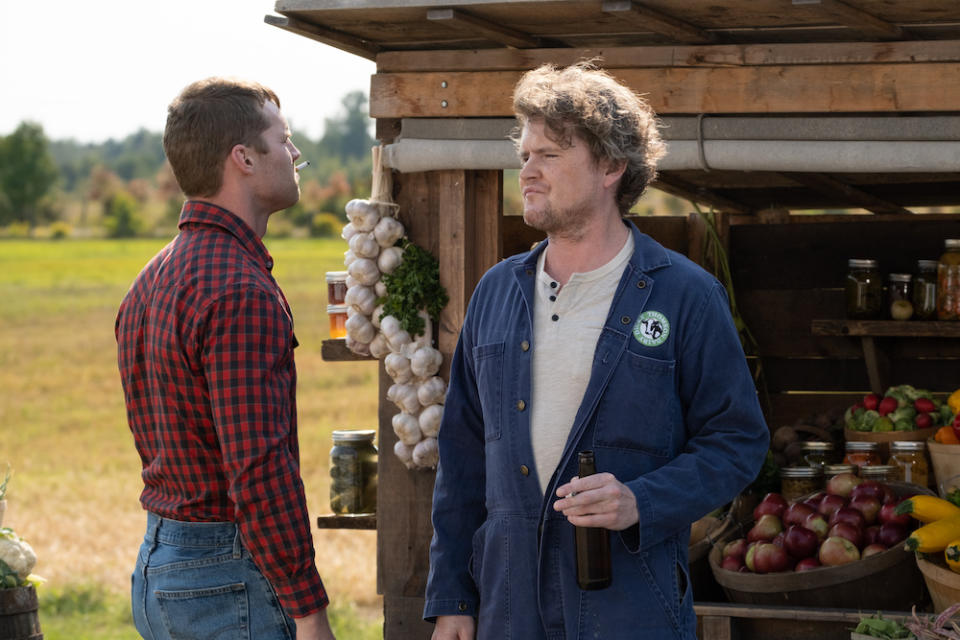After 12 Seasons, Seven Specials and Five Live Tours, ‘Letterkenny’ Says Goodbye
- Oops!Something went wrong.Please try again later.
- Oops!Something went wrong.Please try again later.
- Oops!Something went wrong.Please try again later.

No one knew how many difficulties existed in the fictional town of Letterkenny when the show revolving around small-town hicks, hockey players and skids launched on Super Bowl Sunday 2016. As it turns out, there were enough “Letterkenny Problems” not only to change the lives of all those involved, but to transform the Canadian TV landscape.
When “Letterkenny” cracks open its final six-pack of episodes Dec. 25 on the Canadian streaming service Crave (and on Dec. 26 on Hulu), it ends an era that includes 74 episodes, seven specials, five live tours, branded clothing and booze, Canadian Screen Awards victories, and a spinoff, “Shoresy,” which wraps filming on its third season in Sudbury, Ont. this month.
More from Variety
The most impressive feat, however, may be in how a show with such specificity, from the vernacular to the sets, catapulted into mainstream pop culture and amassed loyal fanbases across Canada and the U.S.
“The more specific you get, hopefully the more universal your experiences become,” writer and director Jacob Tierney, who also plays Glen, tells Variety. “Most small towns have some version of the local sports thing, the local drug thing, the local religion thing. We dug into what we knew.”
Tierney continues: “We were right in that what we thought was funny, other people thought was funny. I guess that sounds obvious, but it doesn’t feel obvious when you’re doing it — especially in the first season of the show.”

Before that first season became a reality, “Letterkenny” creator Jared Keeso had accumulated a small fanbase for his award-winning work on the Bell Media drama “19-2,” and for playing a younger version of Canadian hockey icon Don Cherry in two biopics for the Canadian Broadcasting Corporation. Some of his American credits included “Godzilla” and “I Love You, Beth Cooper,” but he had no interest in heading down to Los Angeles and entering the American star system.
“It’s not really for everybody,” Keeso said in a 2014 unreleased interview with me right before Crave picked up “Letterkenny” as its first original series. “Do you know how hard you have to work in Canada to be a star? To not just be that guy from that thing? You have to work so, so hard for people to know your name in Canada, and for me, there’s something to be said for that.”
Instead, in what he called at the time the best move of his professional life, Keeso sank $6,000 into making the web series, “Letterkenny Problems.” The shorts featured himself and Nathan Dales as hicks hanging out at the produce stand and pontificating about their problems in quick jump cuts. They also chirped hockey players and skids in lightning-fast dialogue that would leave Aaron Sorkin or Amy Sherman-Palladino spinning.
“If you want longevity in the Canadian business, you have to put the work in,” Keeso explained in the same archived interview. “You can’t live and die by what the networks are throwing at you. You can’t die by the audition process because that is a slow, slow death. You have to make your own breaks.”

For Keeso, the end game was always a series. So as the shorts went viral, the head of originals and development for Bell Media, Corrie Coe, put “Letterkenny” into development with Keeso and New Metric Media. When a script was ready, Coe flagged it for the company’s then SVP of programming, Mike Cosentino.
“In May 2014 I was flying home from the L.A. Screenings, and the team and I had watched 30 or so new U.S. network pilots. But it was ‘Letterkenny’ that was blowing up in my mind,” Cosentino recalls, adding that he laughed out loud on the plane. “I was hunting for our first ever Crave Original, and somewhere over Arizona I found it.”
Crave launched in Canada in December 2015 and the first “Letterkenny” six-pack was up two months later. According to Cosentino, it became the biggest thing on Crave, earning more streams than classics like “Seinfeld” or “The Big Bang Theory.”
Justin Stockman, Bell Media’s current VP of English content development and programming, added Crave to his portfolio between the first two seasons. He remembers making the decision to release “Letterkenny” Season 2 on Christmas Day 2016. The episodes dropped early, on Christmas Eve, prompting the Crave team to call Stockman while he was celebrating with his family in his grandmother-in-law’s basement.
“They were like, there’s something wrong,” he recalls. “The viewership was spiking in a way we hadn’t seen before. We were still pretty small, and they were worried something strange was happening — it wasn’t even midnight yet. Then, over the next few days of the holidays, while the office was closed, I was getting all of these email updates. Season 2 was on fire, and Crave was lit up.”
“Letterkenny” also came along just as Canadian production company New Metric Media was launching. President Mark Montefiore grew up in St. Catharines, Ont. and instantly recognized everybody on the show that he grew up with — himself included.
“I thought it was hilarious,” he recalls. “Then our first meeting with Jared was about making a great TV show so we can do all of this other cool stuff, [like] books, movies, and live touring. That was embedded right from Day 1. It’s been quite a catalyst for our company.”
The series went on to achieve a lot of that “cool stuff,” but the actors credit the show’s initial success to a lot of hard work and leadership that fostered collaboration and creativity.
Keeso had cast guys from his beer league hockey team, The Trappers, including Dales, Tyler Johnston (who plays Stewart), and “Letterkenny” hockey players Andrew Herr and Dylan Playfair (Jonesy and Reilly, respectively). The latter two had also appeared as the hockey players in the most-viewed webisode of “Letterkenny Problems,” so when it came time to casting the series, Keeso went to bat for them. They didn’t want to disappoint.
“In the early seasons, we would put in hours and hours of rehearsals before we got on set,” says Playfair. “We made a pact that when we got on set, we wanted to set the tone, to be off-book. To be tight. To run it a million ways to Sunday so that if we got directions, we weren’t caught off-guard.”
“No one wanted to let each other down,” adds Herr. “The show is so rhythm-based that if you try to take a dramatic beat or carve out any space, it just doesn’t work. If you’re not on your cues you’ve ruined the flow of scenes. They’re relying on you to hit it, hit it.”
The hockey players weren’t the only ones who felt as though they had to represent on set. Johnston and Evan Stern, who plays Roald, also wanted to ensure their scenes as the town’s skids were seamless. Looking back, Stern says he sees that hard work as part of the show’s legacy.
“It would be like 2 in the morning, and I would show up in Tyler’s hotel room and we’d read the entire show together and just scream the lines at each other 400 times,” he says. “It’s a memory I’ll always cherish, because I don’t know that I’ll ever be that prepared again. For anything.”
Although they all felt the pressure to not let one another down, all of the actors Variety spoke with credit Tierney for letting them bring their own quirks to their characters. Playfair recalls a huge learning moment while filming the pilot, in which the scene ended but Tierney didn’t yell cut and kept the cameras rolling. Playfair looked at him expectantly, wondering what was happening.
“He walked up to me, and he goes, ‘Dylan, don’t you ever run away from an opportunity to be funny. If I haven’t called cut it’s because I think there’s more to the scene, and that’s your chance to play,’” Playfair recounts. “It has changed the way I act, entirely. What a cool note to get as an actor — ‘It’s your job to swing for the fences.’ And that’s what I did.”
Johnston adds that a lot of the physicality between Stewart and Roald wasn’t scripted, but came about from Tierney’s willingness to let them play. One of the series’ most iconic moments, their kiss in the Christmas episode, was born out of that spontaneity. Tierney and Keeso left it in, making it the only kiss of the entire series.
“Our chemistry helped the characters grow and create a connection with fans because quite clearly, early on, Evan and I and Pat [McNeil] and Danny [VanZandwyck], the other two guys who played the skids, were pretty comfortable doing just about anything,” Johnston says.
Kaniehtiio Horn, Tanis on “Letterkenny” and a consulting producer on “Shoresy,” adds that level of collaboration helped in the creation of authentic Indigenous characters and representation that pushes beyond stereotypes. She points to other characters calling Tanis “Auntie” or being one of the (if not the) first person to say the Indigenous slang word “skoden” on TV, as examples.
“They just trusted me with a lot of my input, and they trusted the other Indigenous characters,” Horn says. “That, to me, is the heart of what collaboration should be between Indigenous people and non-Indigenous creatives.”
Cast members says that trust extended to the whole crew and led to the creation of beloved idiosyncrasies, such as Roald’s high-pitched way of saying “Stewart” or Squirrely Dan (K. Trevor Wilson) adding an “s” to the end of particular words.
Tierney says he saw those moments as risks, and knew leaning into choices — such as making meth-heads the main characters, or having specific hockey storylines — wasn’t conventional. But he’s proud of the way they dug into that world, and kept expanding it.
“I always joke that we’re like ‘The Simpsons,’ because we have 900 supporting characters we can go to at any moment to pick up a storyline for us,” he says. “You can’t service the entire massive cast of the show in six episodes, but it’s amazing what a deep bench we ended up with.”
Wilson wasn’t always on that bench as Squirrely Dan. The part was initially written for Dan Petronijevic, who had starred with Keeso on “19-2.” But when filming commitments on “Suicide Squad” kept him from that first season of “Letterkenny,” the show tagged Wilson in, and eventually created the mumbling McMurray character for Petronijevic instead.
“I felt like I had to bring in some stuff for my character that was different from what the other two Hicks were already doing,” Wilson says. “That first season, I was doing homework every night. I’d figure out where I was going to Squirrely Dan up the dialogue and where I could add the malapropisms and the broken phrasing. I was swinging for the fences every time I got on screen in Season 1 and Season 2.”
In the end, he wanted to be the guy who comes in all “garbage mouth” that no one ever really understood. At the first read-through he did just that, and got a surprising note from Keeso.
“After, Keeso pulled me aside and said, ‘I kind of wanted you do to that. But I didn’t know how to ask you to do that. So I’m really glad that you did that. And if you keep doing that, that’d be great,’” he recalls.
The foundation that “Letterkenny” built over its first six seasons spurred Hulu to pick up the library in 2018, further expanding the fanbase. A year later, “Letterkenny” Season 7 graduated into a Hulu original, with all future episodes set to stream on the service.
Celebrities took note as well. Edward Norton came to the tour in L.A., while Brad Pitt revealed to the cast that “Letterkenny” was the show he threw on when he’d had a rough day.
“They created this brand around the show that resonated with so many people,” says Michelle Mylett, who plays Keeso’s onscreen sister, Katy. “We saw that when we went on these tours, how much of an impact it made on people across America as well as Canada. It became this community that supported us, but also connected with each other — and that’s a really hard thing to achieve.”
When the final season premieres, fans can expect more of the same problems they’ve seen from this crew, with a few extra special nods. The first cold open, for example, dropped early on the show’s YouTube channel, and features an A-to-Z homage of the show’s slang-filled history. There’s also a few call backs to the web series that kicked it all off, as well as a slightly more serialized storyline to push it through to the end.
Keeso stopped doing press shortly after “Letterkenny” debuted, and declined to be interviewed for this story. In a rare exception, though, he spoke about his decision to end the show in an episode of “The Produce Stand” podcast, explaining he’d done everything he could do with the series, and that he looked forward to continuing the world with “Shoresy.”
Behind the scenes, however, he had already reached an overall content deal with Bell Media and New Metric to create a new series and to further expand the world of “Letterkenny” through a combined 49 new episodes for Crave. “In addition to the content commitment, the companies continue to collaborate on existing and new ancillary brand extensions, including merchandise and live productions,” reads an official release.
The companies say more announcements are forthcoming, but for now the “Letterkenny” cast is moving forward with new projects, an open mind about potentially returning to this world, and fond memories of the gig that, in many cases, made their careers.
“Keeso was a hell of a captain,” says Wilson. “He took his leadership role seriously, and I have great admiration for how he handled himself on set. As a boss and a leader, he knew everyone’s names, and he made a point to use them every day.
“He never let anyone feel unimportant or small on that set, and he made everyone know how appreciated their work was.”
Best of Variety
'House of the Dragon': Every Character and What You Need to Know About the 'Game of Thrones' Prequel
Sign up for Variety’s Newsletter. For the latest news, follow us on Facebook, Twitter, and Instagram.

